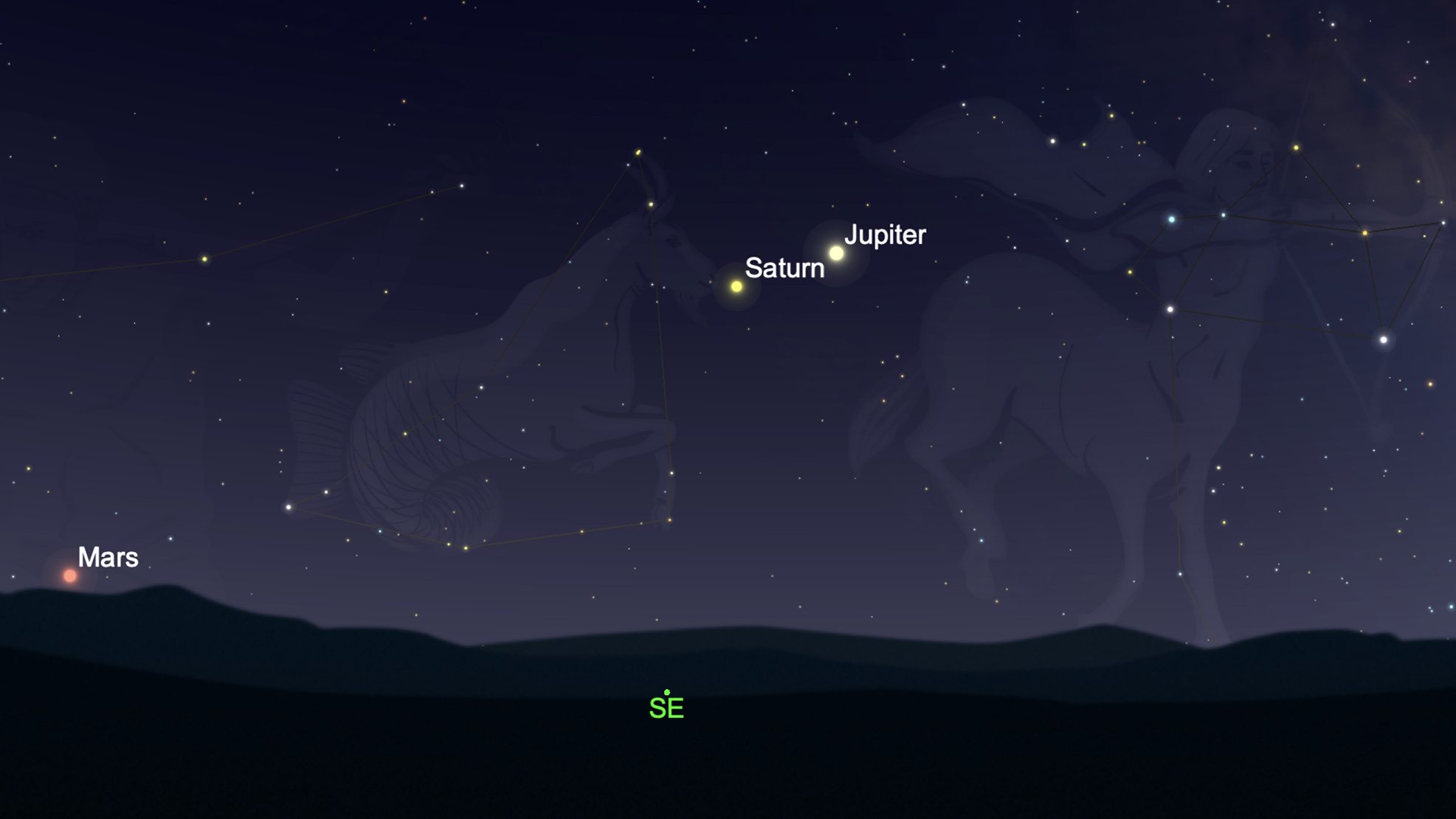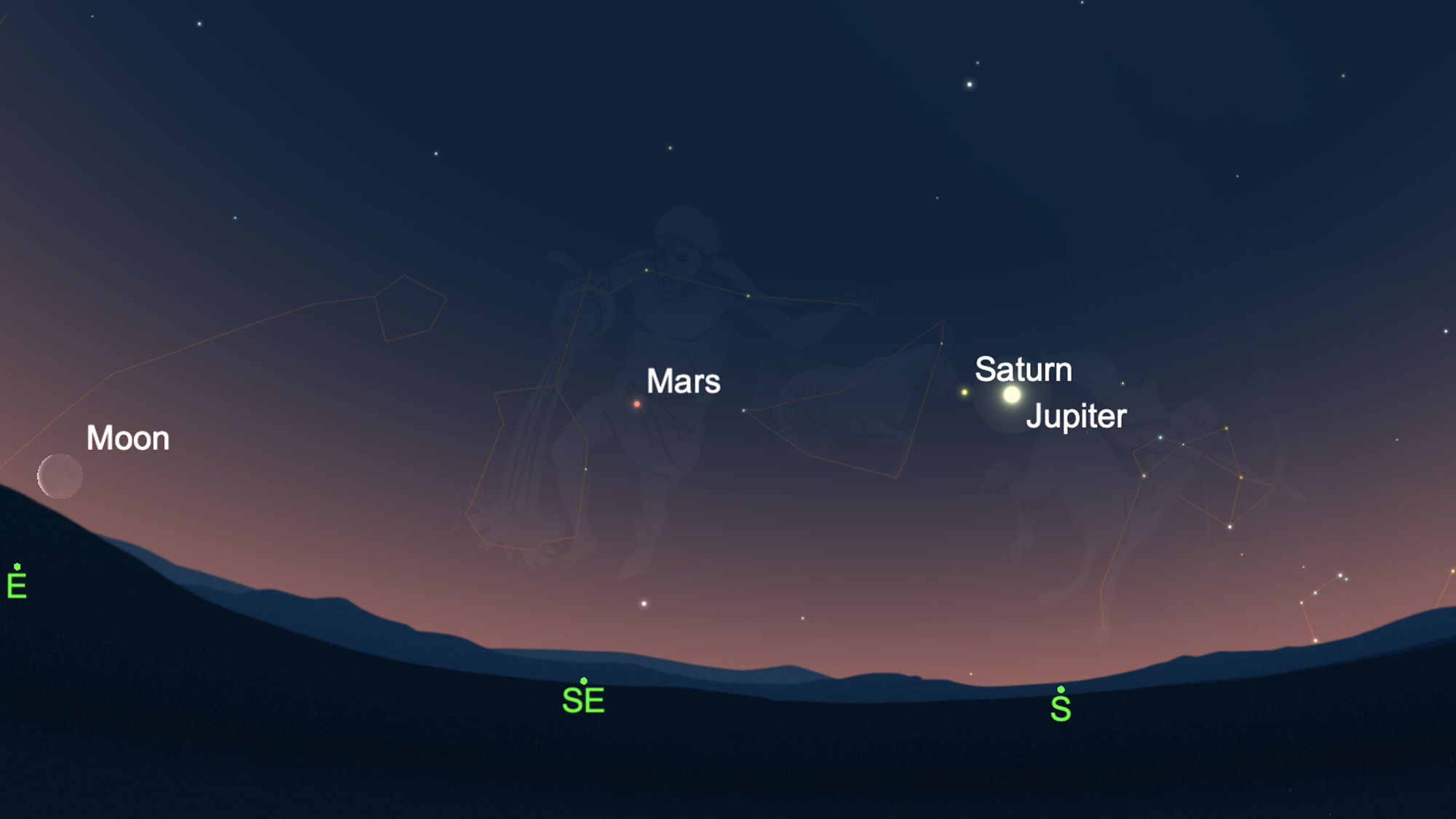See Jupiter and Saturn snuggle up in the predawn sky this week
The two giant planets of the solar system, Jupiter and Saturn, will snuggle up in the predawn sky this week, offering spectacular views for night owls and early risers.
The pair had a close encounter early Monday (May 18), when they were separated by about 4.7 degrees (for reference, your clenched fist held at arm's length is about 10 degrees wide). But the cosmic duo will continue to stick together for the rest of the month, and you can catch them together in the hours between midnight and sunrise.
To see the sky show, all you need are your eyes, a small bit of outdoor space and a clear view of the southeast horizon, which makes the activity achievable even if you are stuck in your house or apartment due to quarantine restrictions.
Related: The brightest planets in May's night sky: How to see them
Jupiter will appear in the constellation Sagittarius, the archer, shining at magnitude -2.5. (Magnitude is a scale of stellar brightness, with smaller numbers indicating brighter objects and negative numbers denoting the brightest objects.) Second only to the moon, Jupiter will be the brightest object in the predawn sky. The only planet brighter than Jupiter is Venus, which rises about an hour after sunrise and dominates the evening sky, shining at magnitude -4.2.
Meanwhile, Saturn will be just to the left of Jupiter, shining at magnitude 0.3 in the constellation Capricornus, the sea goat. The planets will be too widely spaced to fit in a telescope, but you can see them comfortably with the naked eye, or a set of binoculars.
The planetary pair made their closest approach on Monday (May 18) at 12:45 a.m. EDT (0445 GMT), just a few minutes after the two planets rose above the southeast horizon. Both planets will continue to rise shortly after midnight all week long, but if you're watching that early, it may be hard to see them in the murk close to the horizon.
Breaking space news, the latest updates on rocket launches, skywatching events and more!
Luckily, the show continues well into the night, and as the planets rise higher in the sky they will provide a spectacular view until the growing light of dawn washes them out. To get the best view, give your eyes about 20 minutes to adjust to the darkness, and try as best as you can to get away from artificial light. (If you want to use a star chart, we recommend using a red filter on your phone, or on your flashlight.)
While the planets are reasonably close in the sky, the encounter doesn't qualify as a conjunction. To be in conjunction, two celestial objects making a close approach must also share the same celestial longitude. That said, both Saturn and Jupiter came into conjunction with Earth's moon last week.
It's common for planets and the moon to come close to each other in the night sky, because all of them travel on the same apparent path in space, called the ecliptic. The ecliptic represents the plane of the solar system, or the region in space where the planets and Earth's moon orbit on a (virtual) flat disc.
Editor's note: If you have an amazing night sky photo you'd like to share for a possible story or image gallery, you can send images and comments to spacephotos@space.com.
- The brightest planets in May's night sky: How to see them
- When, where and how to see the planets in the 2020 night sky
- Saturn, Mars and Jupiter align over NYC in gorgeous night-sky photos
Follow Elizabeth Howell on Twitter @howellspace. Follow us on Twitter @Spacedotcom and on Facebook.
OFFER: Save 45% on 'All About Space' 'How it Works' and 'All About History'!
For a limited time, you can take out a digital subscription to any of our best-selling science magazines for just $2.38 per month, or 45% off the standard price for the first three months.

Elizabeth Howell (she/her), Ph.D., was a staff writer in the spaceflight channel between 2022 and 2024 specializing in Canadian space news. She was contributing writer for Space.com for 10 years from 2012 to 2024. Elizabeth's reporting includes multiple exclusives with the White House, leading world coverage about a lost-and-found space tomato on the International Space Station, witnessing five human spaceflight launches on two continents, flying parabolic, working inside a spacesuit, and participating in a simulated Mars mission. Her latest book, "Why Am I Taller?" (ECW Press, 2022) is co-written with astronaut Dave Williams.



